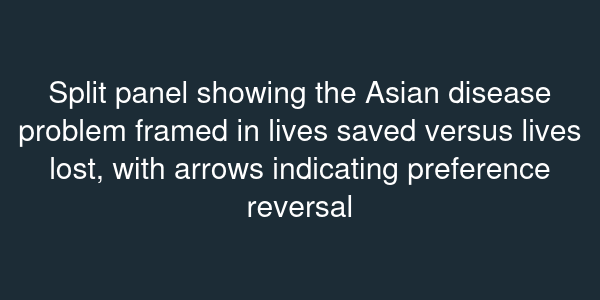Framing Effects
Essential Questions
- How does framing identical payoffs lead to different decisions?
- What does the Asian disease experiment reveal about risk attitudes?
- How can you design communication to harness framing ethically?
Overview
During a public health crisis, you must communicate vaccine data. Option A saves 200 lives for sure; Option B has a one-third chance to save everyone and a two-thirds chance to save none. When you frame outcomes in lives saved, people prefer the certain option. When you frame the same math in lives lost, risk preferences flip. This is the Asian disease problem, a cornerstone of framing effects.
In this lesson, you will analyze how framing influences risk preferences, examine policy cases like energy bills and voter turnout, and practice crafting data visualizations that avoid manipulation.
The Asian Disease Problem
Kahneman and Tversky presented respondents with programs to fight a disease expected to kill 600 people. In the "lives saved" frame, Program A promised that 200 people would be saved with certainty, while Program B offered a one-third probability that everyone would be saved and a two-thirds probability that no one would be saved. Seventy-two percent of participants chose the certain program. When researchers described the same payoffs as losses—Program C ensuring that 400 people would die and Program D giving a one-third chance that nobody would die but a two-thirds chance that everyone would die—risk preferences reversed, with 78% choosing the risky option. The outcomes are mathematically identical, but the gain frame invites risk aversion while the loss frame invites risk seeking.

Mechanisms
Framing effects arise because reference points shift with context. In gain frames, the reference is the status quo; certain gains feel safer. In loss frames, avoiding certain death becomes paramount, activating the convex part of the value function. Neural evidence shows different brain regions activate under gain versus loss frames, indicating emotional pathways.
Beyond the Lab
Energy companies learned that labeling usage as "above average" reduces consumption more effectively than listing kilowatt-hours. Ballot initiatives framed as "protecting choice" versus "limiting rights" receive different support even with identical legal text. In finance, presenting retirement contributions as "increasing take-home pay later" versus "reducing today's paycheck" shifts participation.
You must ensure ethical framing. Transparency requires that different frames remain truthful and avoid coercion. Policy designers often test frames using randomized controlled trials while monitoring for unintended inequities.
Applying Framing
When you communicate data, consider the reference points your audience holds. Presenting COVID-19 statistics as survival rates may reduce urgency compared to death rates. Conversely, encouraging vaccinations by highlighting the number of people protected can foster communal action. You can model framing by allowing the utility function to depend on descriptive labels : . Choosing alters perceived gains or losses.